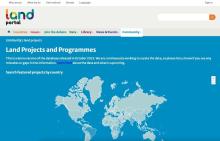Land Library
Welcome to the Land Portal Library. Explore our vast collection of open-access resources (over 74,000) including reports, journal articles, research papers, peer-reviewed publications, legal documents, videos and much more.
/ library resources
Showing items 1 through 9 of 36.This is the dataset from 26.03.2024 of Land Portal's Projects Database - a dataset curated by the Land Portal's team. The dataset includes information about +3,800 development projects with objectives related to land governance.
Issues relating to land are specifically referred to in five of the United Nations’ (UN) 17 Sustainable Development Goals, and UN-Habitat’s Global Land Tools Network views access to land and tenure security as key to achieving sustainable, inclusive and efficient cities.
According to the United Nations (UN) Refugee Agency, there were 79.5 million forcibly displaced people worldwide by the end of 2019. Evictions from homes and land are often linked to protracted violent conflict.
A cadastre, as one of the key registers of land administration, must be maintained to provide up-to-date land information. Before digitization, technical and alphanumerical datasets were maintained separately, leading to redundant data.
The report is based on a collaboration between the Council for Scientific and Industrial Research (CSIR) in South Africa and the Land Portal Foundation, in collaboration with local partners, in individual countries.
This article summarizes the evidence on youth land rights in Liberia from a literature review combined with primary research from two separate studies: (1) A qualitative assessment conducted as formative research to inform the design of the Land Rights and Sustainable Development (LRSD) project f
An increasing number of African States are recognizing customary land tenure. Yet, there is a lack of research on how community rights are recognized in legal and policy frameworks, how they are implemented in practice, and how to include marginalized groups.
Limiting global warming to well below 2 degrees Celsius and better even to 1.5 degrees Celsius, according to Article 2 paragraph 1 of the Paris Agreement requires global zero emissions in a very short time.
In recent decades, mechanisms for observation and information production have proliferated in an attempt to meet the growing needs of stakeholders to access dynamic data for the purposes of informed decision-making.





